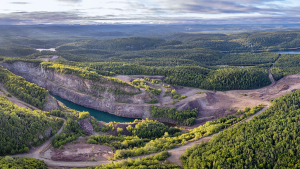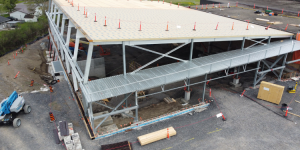One of the biggest players in the Ring of Fire says as soon as the Ontario government puts shovels in the ground to kick off construction on an all-season road north, it will get to work developing the first of its mines in the region.
That could mean, if construction of the road promised by Premier Kathleen Wynne last August starts in 2019 and wraps in 2022, Noront Resources could begin producing nickel and copper out of its Eagle’s Nest deposit in late 2022.
Soon thereafter, Noront CEO Alan Coutts laid out in a recent interview, the miner would turn to its nearby Blackbird chromite deposit and launch a “generational” new era of mining in Canada.
“The chromite deposits are by far the largest deposits in the region and right now with the acquisition of Cliffs chromite resources and our own discoveries, we have a mineral resource that would last 100 years in the Ring of Fire,” Coutts said.
Located in the James Bay lowlands of northern Ontario, the Ring of Fire contains proven mineral deposits worth hundreds of billions of dollars, including nickel, copper, zinc, platinum, palladium, gold, diamonds and North America’s first commercial deposits of chromite.
Chromite is processed into ferrochrome to produce stainless steel, highly sought after by China, which represents 60 per cent of the world’s demand, the northeastern U.S., Europe and elsewhere.
Coutts said the costs of developing Noront’s first chromite mine would be $200 million and then building a ferrochrome smelter would cost $1 billion.
The firm had balked at spending another $1 billion on a 300-kilometre roadway to take its chromite ore south, but the premier’s announcement last summer that the province was working with First Nations on developing two possible roadways, an east-west route from Pickle Lake and a north-south corridor from Aroland to the Ring of Fire, opened the door for Noront to contemplate next steps.
Both Coutts and Moe Lavigne, vice-president for exploration at Toronto-based KWG Resources, identified co-operation with First Nations as a significant remaining hurdle to development.
Lavigne said he suspects potential investors such as China, whose China Railway company has completed feasibility studies into constructing KWG’s preferred infrastructure option, a $2-billion railway line, are sitting out the development process until First Nations issues are resolved.
A statement from the provincial Ministry of Northern Development and Mines (MNDM) confirmed the initial timeline laid out by Wynne, with the province aiming to obtain permitting and agreements with First Nations this year and next with the start of construction slated for 2019. The Webequie and Nibinamik First Nations have confirmed their partnership in the east-west roadway development process and an MNDM spokesperson said the province is working with the Marten Falls First Nation to plan and construct the roadway from Aroland.
Lavigne said negotiations with other First Nations are up in the air.
Said Coutts, “Timelines are somewhat uncertain because of the desire for all these people to be involved in decisions around resource development. We get that, we have factored that into our timelines.
“We feel with some of the strong relationships we have with the Marten Falls and Webequie First Nations, we will be able to attain those goals and have the communities involved to the level they want to be involved.”
Noront has already worked with Marten Falls on skills training. Coutts said after the Marten Falls chief visited the base camp in the Ring of Fire, where 20 of the 30 workers are Indigenous, he was sufficiently impressed to sign an agreement.
The firm has handed over environmental and engineering reports prepared by Golder and Hatch to the First Nations as they take the lead in developing the road systems.
Noront controls some 80 per cent of the mineral deposits in the Ring of Fire and Coutts said it intends to further analyze deposits in the area to be able to withstand swings in commodity prices.
Noront recently launched an RFP process to identify a site for its massive ferrochrome smelting plant. By closing day, Feb. 2, interests in Sault Ste. Marie, Sudbury, Thunder Bay and Timmins, which each had brownfield sites that would enable streamlining of the permitting process, had submitted bids. Hatch will be sorting through the proposals to help Noront reach a final decision, expected later this year.
Lavigne cited other issues to be resolved before his firm’s plan to partner with China Railway gets off the ground, including feasibility studies and environmental approvals and ensuring KWG’s patented low-heat ferrochrome-processing technology can be replicated on a commercial scale. But he remains convinced rail is the most efficient way to get chromite ore south and points to a study released by KWG that he said makes the point convincingly.
KWG builds could include the mine itself, the railway — potentially paid for by China Railway in exchange for chromite — a gas power plant, a concentrator and a processing plant.
Noront would have its other minerals besides chromite sent to existing Ontario or Quebec smelters and would initially install diesel generators for power at its mines. Coutts said the chromite from its Blackbird deposit was so pure it did not require processing in a concentrator before shipping for processing.
Noront is closer to getting to the production stage but Coutts said there are two non-logistical issues that threaten to derail the whole project — carbon pricing and energy pricing.
“We will have a best-in-class ferrochrome processing plant…but it is very electricity-intensive and produces a large amount of greenhouse gases, so these are two things we will need to have stability and certainty around with the province before we actually undertake construction of the plant,” he said.
Coutts was asked if the issues were deal breakers.
“Not so much greenhouse gases but the power price is a deal breaker, yes,” he said.











Recent Comments